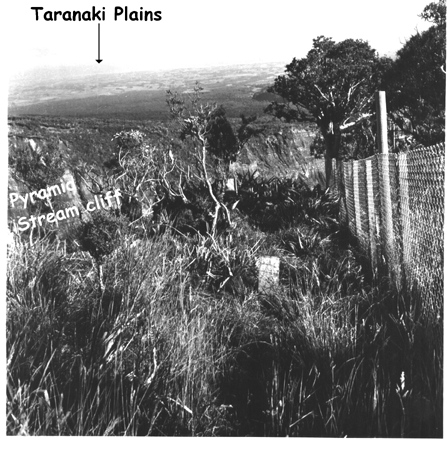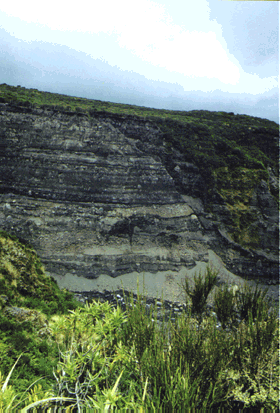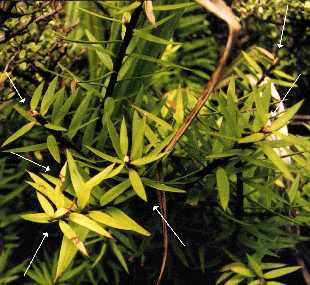Press any of the buttons below to go to my other
pages.




You are currently on a

page.
Disclaimer: these pages reflect my own personal
opinions and do not necessarily reflect Department of Conservation
policy or opinions

Still flying high!!
Goats and exclosure plots
in
Mt Egmont Park.

My next helicopter trip was in quite
a different area, over Mt Taranaki. Landcare research has a project
going where they sample leaflitter and soil organisms from exclosures
around the country. They try to sample a range of habitats, from
lowland to montane and from the tip of the North Island to the
offshore sub-Antarctic islands. One of the few remaining intact
exclosure plots on Mt Egmont was included in the selection.
Neither DB nor I had ever been there, and we wanted to inspect
that exclosure plot and try to locate another one nearby. Exclosure
plot 6 is precariously balanced above Pyramid stream in sub-alpine
scrub. The helicopter hovered with one skid touching the ground,
the other suspended over the 100-m cliff, and we gingerly edged our
way out.
Sub-alpine scrub has a reasonably low stature. This is one
of the reasons we knew that the exclosure still exists, it is
visible from the air. The plot was constructed in 1973 on true right
side of Pyramid stream, in the montane scrub zone above plot 8.
Altitude approximately 3000 feet above sealevel.
Construction:
1973 -The fence consists
of four rows of 12 gauge H/T wire covered with 3’6" high 2 inch
chain mesh. Trees and 8’ tanalised posts are used for posts. Forty
battens have been attached at 3’ intervals. Further battens are
required to complete the plot (approx. 40).
No sampling plots have been established yet. Deferred until November 1973
1974 - Construction not yet completed. Approximately 40 battens
are required and steel pins to hold the chain mesh to the ground.
This material will be flown in with the 1974/75 supply drop.
No sampling plots have been established yet. This will be done in conjunction
with the completion of the plot.
I'm not sure when the
construction of the fence was completed, but it was basically intact
when we visited it. One edge of the exclosure is now partially
suspended over the 100-m cliff into Pyramid stream, but even goats
would have difficulty squeezing in by that route.
Vegetation description
1973 - This plot is
situated on the western extremity of the
Upson/Pyramid "dead area" but in an area still composed of more of
less the original canopy with a few additions.
A "dead area" is an area where most of
the trees and plants have been eaten out or killed by combined goat
and possum browsing. There are some photo's beyond this passage to
illustrate what is meant. The exclosure was put in to see what
effect goat browsing had on the growth and composition of the
vegetation.

Canopy:
Scenecio (now Brachyglottis) elaeagnifolius
(leatherwood)
, Coprosma parviflora
, Hebe stricta, Dracophyllum, Neopanax
(now Pseudopanax) simplex var. sinclarii,
Cassinia and occasional Griselinia littoralis.
Groundcover: Mostly Astelias, Uncinia
grass and Blechnum capense.
Regeneration: Mostly Coprosma tenuifolia,
Scenecio and Hebe stricta.
Browsing and trampling by resident goat population is marked along
and adjacent to the cliff edge above Pyramid stream. Occasional
dead Scenecio, Hebe and Neopanax stems observed.
Recent browsing is confined to Astelia trinervia and almost
all plants in the area have suffered moderate to heavy browsing,
presumably in the absence of other preferred species of edible
size.
A small pocket of goats has resided in the area for considerable
time. Occasionally shot but soon replaced from the surrounding
scrub, not from "dead area" but further upstream in more
Scenecio scrub.
1974 - This plot is situated in the Upson/Pyramid dead area.
Canopy: Scenecio elaeagnifolius, C. parviflora
, Hebe stricta, Dracophyllum, ,
N. simplex var sinclarii and Cassinia.
Groundcover: Mostly Astelias, Uncinia
grass and Blechnum capense.
Along the cliff edges is a heavily browsed animal track which is
in keeping with other such areas throughout the scrub zone. The
heavily browsed area is approximately 100 yards long and is in the
immediate area of this plot.
Goats have also been inside the plot and heavy browsing can be seen
on Astelia plants.
The general area around this plot holds a moderate population of
goats

This is what the descriptions are
talking about. The photos are taken in 1973 and show how the
scrublands, that used to be there, have been eaten bare and now
resemble some sort of "pasture". This particular photo is taken looking
back towards the peak of Mt Egmont. The stream is on our right,
about 100-m down the cliff. The spot where we are "standing" no
longer exists, it is now sheer cliff and the fence is suspended
just over the edge of it.
There are a few taller plants inside the exclosure, but they are
sparse and badly chewed. The colour photo of the plot, that I took
this year, is taken from the far corner.

This photo is taken from roughly the same spot as the
previous one, but looking in the opposite direction. You can see
some of the surrounding Taranaki plains in the distance. The cliff
down into the Pyramid Stream is on our left. I've labeled it on the
opposite bank. Erosion since 1973 has reduced this area to a 1 m
wide ledge. Again note the lack of significant vegetation and the
barren looking specimens that you can see.

This is what it looks like now. DB is standing inside the plot,
by the post that I highlighted in the first picture. The stream
is on our left and we are looking towards the plains. DB is not
particularly short, about 1.7 m I guess. You can see how much more
lush and taller the vegetation has become. I have another photo
somewhere (can't find it at the moment) that shows that the
vegetation outside the exclosure plot is nearly as tall.
What that means is that there is very little difference in growth
between the fenced off area (to keep the goats out) and the goat
accessible area outside. Maybe not quite what you were expecting,
but then conditions have changes somewhat since 1973. The goat
control programme on Mt Taranaki has been stepped up considerably
since then. The fact that the plants are lush and tall shows
that elimination of goats has a very positive effect on vegetation
growth and composition. Furthermore, goats in this area have been
reduced to such low numbers that they have little impact on any of
the vegetation.
This is great news !!!

It means that all our efforts
are paying off and we are making a difference. Even species like
kamahi (Weinmannia racemosa) are starting to make a comeback.
Note the tall cabbage tree behind DB in the photo (Cordyline
indivisa). No mention at all of that species in the vegetation
descriptions of 1973/74 but they are plentiful in the area now.
That is excellent, and only partially because it is one of my
favourite species.
Just a quick bit of history. Goats were introduced into the
surrounding farmland to help control blackberry. They did this
rather well, but because there were no fences on the boundaries,
the goats also migrated into the park with devastating consequences
on the understory vegetation.
 Most of the park is fenced now, but goats are gnarly creatures
and quite capable of climbing through fences. The District council
is considering banning goats from a 2 km radius around the park
(like deer are excluded at the moment) to reduce goats in the
immediate area. If that happens it might be possible to eradicate
goats completely from the park one day. This can't happen until
there are no sources of goats left on surrounding land to reinvade
the park. It will be a major undertaking to get the last few goats.
The area is steep and many parts are inaccessible to humans, but
not to goats.
Most of the park is fenced now, but goats are gnarly creatures
and quite capable of climbing through fences. The District council
is considering banning goats from a 2 km radius around the park
(like deer are excluded at the moment) to reduce goats in the
immediate area. If that happens it might be possible to eradicate
goats completely from the park one day. This can't happen until
there are no sources of goats left on surrounding land to reinvade
the park. It will be a major undertaking to get the last few goats.
The area is steep and many parts are inaccessible to humans, but
not to goats.
This is a picture of the cliff on the other side of pyramid stream.
It is at least 100 m high. You can see the layering of the ash
and rocks from different volcanic explosions. Bits were constantly
dropping off the cliff as we stood there. Goats will be able to
climb up and down some of these cliffs and escape. Humans are not
quite so nimble.

Possums are still causing problems. All the new tips and some of
the leaves on this Hall's totara (Podocarpus totara) have been
bitten off by possums. The poison drop of 4 years ago knocked
possum numbers back severely, but they are starting to have major
impacts again. Even this high up the mountain. Apparently no area
is safe from possums, they even get right up the top above the
tussock fields.
At least we are managing to hold our own a bit in the park now,
keeping goats and possums more or less under control and giving the
vegetation a break from being chewed to death. I have some slides,
that I must get scanned in, showing some of the severe damage by
possums in the past in the Park. Until next time.
Back to the diary index
| More about me
| More about my PhD
| Other adventures
This page hosted by  Get your own Free Home Page
Get your own Free Home Page
![]()

![]()





 Most of the park is fenced now, but goats are gnarly creatures
and quite capable of climbing through fences. The District council
is considering banning goats from a 2 km radius around the park
(like deer are excluded at the moment) to reduce goats in the
immediate area. If that happens it might be possible to eradicate
goats completely from the park one day. This can't happen until
there are no sources of goats left on surrounding land to reinvade
the park. It will be a major undertaking to get the last few goats.
The area is steep and many parts are inaccessible to humans, but
not to goats.
Most of the park is fenced now, but goats are gnarly creatures
and quite capable of climbing through fences. The District council
is considering banning goats from a 2 km radius around the park
(like deer are excluded at the moment) to reduce goats in the
immediate area. If that happens it might be possible to eradicate
goats completely from the park one day. This can't happen until
there are no sources of goats left on surrounding land to reinvade
the park. It will be a major undertaking to get the last few goats.
The area is steep and many parts are inaccessible to humans, but
not to goats.